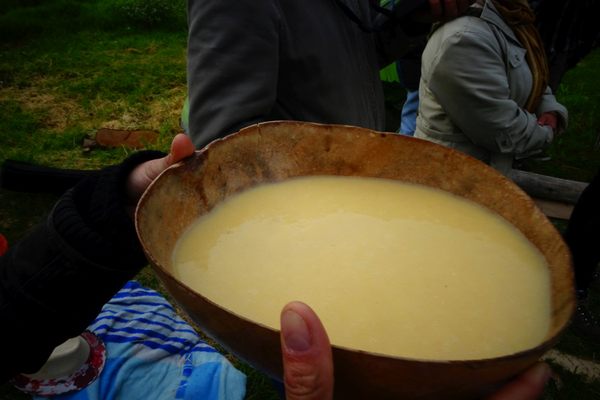The Aztec goddess Mayahuel is frequently portrayed with 400 breasts, each one pouring agave sap. The sweet liquid is also thought to be her divine blood. According to ancient myth, the first agave plant sprouted at the site of her burial.
People living in present-day Mexico have used Mayahuel’s blood, which they call aguamiel (“honey water”), for thousands of years. Fermenting and distilling the agave plant’s core yields tequila or mezcal, while fermenting the sap produces the lesser-known drink pulque.
Tlachiqueros, who harvest the liquid, initiate the fermentation process by cutting out the center of the agave plant. Pulque has a short life: The sugars typically take just 3–6 hours to ferment and spoil within a few days. For this reason, the drink isn’t readily available outside Mexico, like its distilled cousins.
The milky beverage contains only 2–8 percent alcohol, but don’t be fooled. Donnie Masterson, an expert in Mexican cuisine, says pulque doesn’t get you drunk, but then “you get up to leave and realize your legs don’t really work right. Your mind is completely clear, but your body doesn’t work.”
Some consider the finished product “slimy and sour-tasting,” but its flavor is secondary to its medicinal and ritual purposes. Healers have used pulque to treat diabetes, stomach pains, and infertility. In pre-Colombian times, Aztecs revered the powerful elixir; only priests, nobles, and sacrificial victims were permitted to drink it.
Pulque’s status took a hit with the arrival of Spanish-Christian colonialists in the 16th century. As they stamped out local religions, pulque became less sacred. After a long day, workers unwound at one of the many new pulquerías, where the feared “drink of the gods” became a happy hour libation. In the early 20th century, more than 1,000 vendors were serving foamy cups of fermented sap around Mexico City. By the 1950s, beer—with its longer shelf life and status-enhancing reputation—stole Mexico’s attention. The number of pulquerías fell to 80.
Now, thanks to a cultural revival, pulque has gained a new following. “Neo-pulquerías” offer the historic beverage with a twist. While some bars offer updated versions mixed with fruit (called pulque curado), it might be best to stick to the original recipe. Why taint the fermented blood of an Aztec goddess with juice from an ordinary plant?
Where to Try It
-
Las Duelistas
Aranda 28 Colonia Centro, Mexico City, 06400, MexicoThis popular pulquería in Mexico City offers a wide variety of pulques.
-
Pulquería La Hija de Los Apaches Website
Claudio Bernard 149, Doctores, Ciudad de México, 06720, MexicoThis place is easy to find and easy to get into if you speak a little Spanish. Inexpensive dive bar, packed after work. Get ready to dance your face off. Worth it for the bucket of pulque and the art alone (the owner, Pifas, has replaced all faces with his own).
Written By
 rachelrummel
rachelrummel
Edited by
Sources
- www.bbc.com/travel/story/20141125-mexicos-ancient-drink-makes-a-comeback
- www.theguardian.com/travel/2017/jan/01/mexican-heritage-in-a-glass-tasting-pulque-in-mexico-city
- www.chicagotribune.com/dining/drink/ct-pulque-drink-food-0129-20170124-story.html
- www.thoughtco.com/mayahuel-the-aztec-goddess-of-maguey-171570
- books.google.com/books?id=OaNUPMAtISQC&pg=PT10&lpg=PT10&dq=pulque+to+treat+illness&source=bl&ots=wRIlhZJ0WY&sig=nPKKG6k6U50uf9SsnpsGuWf_GLY&hl=en&sa=X&ved=0ahUKEwjeib2QmvHXAhXMPRQKHYH-CYsQ6AEILTAB#v=onepage&q=pulque&f=false
- www.conecto.mx/en/an-age-old-profession-tlachiqueros/
- www.homebrewersassociation.org/how-to-brew/pulque-mexicos-ancient-fermented-beverage/
- www.ncbi.nlm.nih.gov/pmc/articles/PMC4928461/






 nathanlouis1
nathanlouis1








